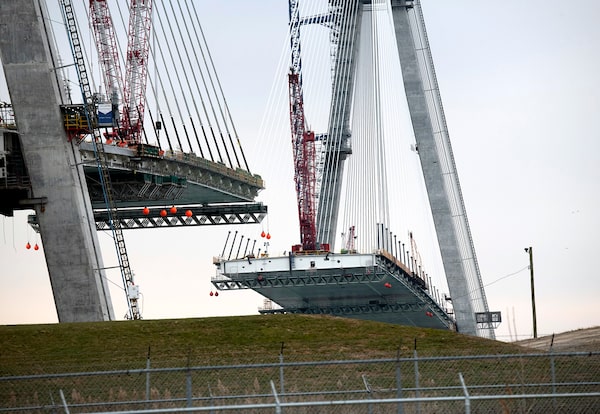
Construction of the Gordie Howe International Bridge that will connect Windsor, Ont. to Detroit, Michigan, is photographed on Nov. 25, 2023. The section at left is being built from the Canadian side and the right section, from Detroit, Michigan.Fred Lum/Supplied
If it feels like the whole country is under construction, that’s because it pretty much is. Infrastructure investment topped $91 billion last year, the highest level on record after accounting for inflation, according to Statistics Canada. The largest single sector was transportation, which soared to more than $27 billion. That’s a lot of pylons.
The surge is largely due to a massive increase in government spending that aims to plug an infrastructure deficit estimated to range anywhere from $150 billion to $600 billion. Public-sector investment in highways, roads, bridges and tunnels matched an all-time high last seen during the building frenzy brought on by Stephen Harper’s Great Recession stimulus program.
While roads and highways account for the largest share of transportation spending, rail projects are coming on strong. Each year, ReNew Canada, a magazine focused on public infrastructure, ranks the 100 largest projects by confirmed cost. In 2024, rail projects account for 15 of the top 25, including GO Transit’s massive expansion project, Montreal’s REM and Calgary’s Green Line LRT. A decade ago, only five rail projects cracked the top 25.
Despite the big dollar figures, it’s still not clear Canada is digging itself out of its infrastructure deficit. Between the 1980s and 2000, public spending on infrastructure fell from 3% of GDP to 1.7%. It rebounded in the years after, but at 2.7% in 2023, it’s roughly where it was back in 2013. In other words, it’s keeping pace with economic growth, but that’s not the same as getting ahead of the problem.
More from this issue of ROB magazine:
-
Cover story:
Reigning cats and dogs: How Pet Valu monetizes our unconditional fur-baby love -
Editor's Note:
Toronto has fallen into disrepair. How is Olivia Chow going to fix it? -
Best Executives 2024:
Out of the spotlight: Hailing the unsung executives who move their companies forward -
Feature:
Monsters Inc.: How Montreal’s RodeoFX clawed its way to the top of the visual-effects business -
Big Idea:
Artificial intelligence is changing how companies snoop on each other